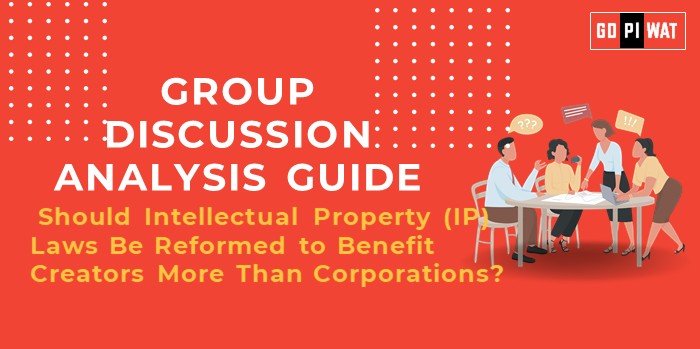📋 Group Discussion (GD) Analysis Guide
💡 Topic: Should Intellectual Property (IP) Laws Be Reformed to Benefit Creators More Than Corporations?
🌐 Introduction to the Topic
- Opening Context: Intellectual Property laws significantly influence innovation, creativity, and economic growth, yet debates persist about whether they primarily serve corporate interests over individual creators.
- Topic Background: Originating to protect creators’ rights, IP laws now frequently favor large corporations due to factors like enforcement capabilities and resource asymmetry. Recent cases, including disputes in the tech and entertainment industries, highlight the need for reform.
📊 Quick Facts and Key Statistics
• 🌍 Global IP Revenue: $1 trillion annually, showcasing IP’s economic impact.
• 🎨 Creator Royalties: Individual creators earn less than 10% of revenues from copyrighted works (World IP Report, 2023).
• 📜 Patent Ownership: Over 60% of patents are held by corporations, emphasizing disparity in resource allocation.
• 💸 Litigation Cost: Average IP dispute costs $3 million in the US, limiting access for smaller creators.
• 🎨 Creator Royalties: Individual creators earn less than 10% of revenues from copyrighted works (World IP Report, 2023).
• 📜 Patent Ownership: Over 60% of patents are held by corporations, emphasizing disparity in resource allocation.
• 💸 Litigation Cost: Average IP dispute costs $3 million in the US, limiting access for smaller creators.
🤝 Stakeholders and Their Roles
- 🧑🎨 Creators: Innovators, artists, and researchers advocating for fair compensation.
- 🏢 Corporations: Entities leveraging IP for profits and market control.
- ⚖️ Governments: Legislators balancing economic growth with equitable IP distribution.
- 🌐 International Organizations: WIPO and WTO promoting global IP standards.
🏆 Achievements and ⚠️ Challenges
Achievements:
- ✨ Innovation Encouragement: IP laws drive technological and artistic advancements.
- 💹 Economic Growth: Strong IP protection fosters international investment.
- 🌏 Global Standards: Harmonization through treaties like TRIPS.
Challenges:
- ⚖️ Creator Inequity: Disproportionate benefit distribution.
- 🚧 Accessibility Barriers: High costs of IP filing and enforcement.
- 🏙️ Corporate Monopoly: Concentration of IP rights stifling innovation.
🌍 Global Comparisons:
- 🇺🇸 US: Strong enforcement benefits corporations.
- 🇸🇪 Sweden: Balanced IP laws emphasize creator rights.
Case Study: 🇮🇳 India: Emerging market with growing reforms favoring startups over large IP holders.
📖 Structured Arguments for Discussion
- 📈 Supporting Stance: “Reforming IP laws to benefit creators ensures fair compensation, fostering sustained innovation.”
- 🏢 Opposing Stance: “Strong corporate IP rights drive global investments and large-scale innovation.”
- ⚖️ Balanced Perspective: “IP law reform must balance incentivizing creators and ensuring scalable economic benefits.”
🎯 Effective Discussion Approaches
Opening Approaches:
- 📊 Start with the economic disparity highlighted by creator earnings.
- 📚 Use a case study of recent IP litigation favoring corporations.
Counter-Argument Handling:
- 🌍 Highlight models like Sweden for balanced IP reform.
- 📈 Use statistics on economic growth driven by equitable IP practices.
🛠️ Strategic Analysis of Strengths and Weaknesses
- Strengths: Promotes innovation, global standardization.
- Weaknesses: Costs, monopolization.
- Opportunities: Encouraging SMEs and creators.
- Threats: Reduced corporate investment.
🎓 Connecting with B-School Applications
- Real-World Applications: Policy evaluation, creative industries’ economics.
- Sample Questions:
- 💡 “How can IP reforms drive innovation among SMEs?”
- 📚 “Discuss corporate dominance in IP law enforcement.”
Insights:
1️⃣ Innovators must advocate for accessible IP protection.
2️⃣ Understand corporate and legislative strategies for negotiation.
1️⃣ Innovators must advocate for accessible IP protection.
2️⃣ Understand corporate and legislative strategies for negotiation.


